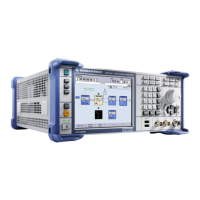Instrument Function
R&S
®
SMBV100A
283Operating Manual 1407.6062.32 ─ 08
The difference between PEP and LEVEL depends on the modulation type and the filter-
ing: Both values are pre-measured internally so that the displayed values match the true
values in the signal. When external signals are used, they are replaced by PRBS data
during pre-measurement.
5.8.3.2 Modulation Types - Custom Digital Mod
The available predefined modulation types are ASK (amplitude shift keying), FSK (fre-
quency shift keying), PSK (phase shift keying) and QAM (quadrature amplitude modu-
lation). Additionally, a user defined modulation mapping can be applied (see "User Map-
ping" on page 286).
The actual modulation procedure is described by mapping, which assigns I and Q values
(PSK and QAM) or frequency shifts (FSK) to every modulation symbol that occurs. This
is represented graphically in the constellation diagrams.
The mapping for the selected modulation type is displayed in the "More..." submenu in
the "Modulation" menu section (see "More - Modulation Type - Digital Modula-
tion" on page 301).
The QAM procedures 16QAM, 32QAM, 64QAM have been produced in accordance with
ETSI standard ETS 300429 for digital video broadcasting (DVB). The QAM procedures
256QAM and 1024QAM are not specified in this standard, but have been produced
according to the same basic principles.
In the case of all FSK procedures, the user can set the symbol rate fSYMB up to a max-
imum value (see data sheet). If MSK is selected, the frequency deviation (FSK deviation)
cannot be set since it is permanently set to ¼ of the symbol rate.
Table 5-2: Modulation type and associated mapping
ASK
1 bit per symbol
SOUR:BB:DM:FORM ASK
PSK
BPSK
1 bit per symbol
SOUR:BB:DM:FORM BPSK
QPSK
2 bits per symbol
SOUR:BB:DM:FORM QPSK
QPSK 45° Offset
2 bits per symbol, 45° rotation
SOUR:BB:DM:FORM QPSK45
Baseband Signal - Baseband Block

